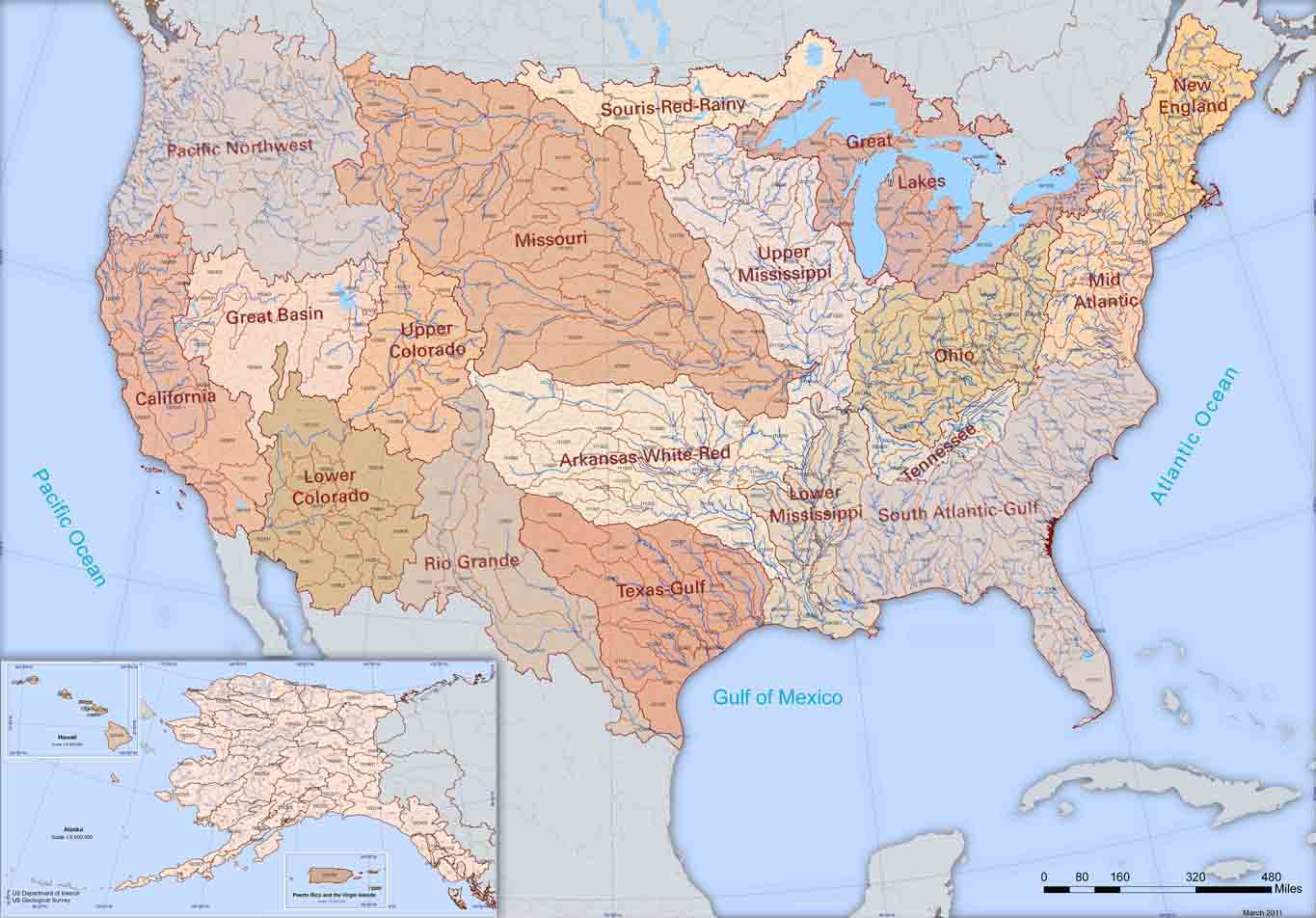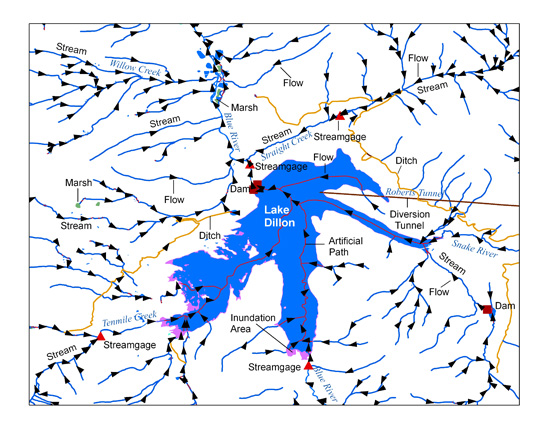Filters: Tags: WBD (X) > Types: Map Service (X)
14 results (73ms)|
Filters
Date Range
Extensions Types
Contacts
Categories Tag Types Tag Schemes |
Regional regression equations were calculated in Puerto Rico with generalized least squares techniques to estimate flood frequency statistics at ungaged locations using drainage area as the only explanatory variable. The island was divided into 2 regions to minimize residuals. The region division that resulted in lower and more balanced residuals runs primarily north-south near the center of the island, mostly along an 8-digit hydrologic unit code (HUC8) boundary. The division line runs through a HUC8 polygon on the southern end of the island, but care was taken to include entire watersheds and consideration was given where hydrologic and physiographic properties differed. This data release includes geographic information...
Types: Map Service,
OGC WFS Layer,
OGC WMS Layer,
OGC WMS Service;
Tags: HUC,
Puerto Rico,
WBD,
Watershed,
Watershed Boundary Dataset,
This layer represents the number of Tier 1 fish species known to occur in each HUC10 watershed in the state, according to data available in CPW’s fish database as of December 2014. There are 25 fish species on the Tier 1 SGCN list; a maximum of eight different species occur in the same watershed. This map is an indicator of species richness only; it does not consider relative habitat quality, or population metrics such as density or abundance, across watersheds.
Categories: Data;
Types: Citation,
Downloadable,
Map Service,
OGC WFS Layer,
OGC WMS Layer,
Shapefile;
Tags: Basin,
HUC,
HUC12,
Hydrologic Unit Code,
Hydrologic Units,

The Watershed Boundary Dataset (WBD) from The National Map (TNM) defines the perimeter of drainage areas formed by the terrain and other landscape characteristics. The drainage areas are nested within each other so that a large drainage area, such as the Upper Mississippi River, will be composed of multiple smaller drainage areas, such as the Wisconsin River. Each of these smaller areas can further be subdivided into smaller and smaller drainage areas. The WBD uses six different levels in this hierarchy, with the smallest averaging about 30,000 acres. The WBD is made up of polygons nested into six levels of data respectively defined by Regions, Subregions, Basins, Subbasins, Watersheds, and Subwatersheds. For additional...
This dataset represents one of three derived outlets or "pour points" for each 12-digit hydrologic unit (HU12) in the Watershed Boundary Dataset (WBD) snapshot delivered with NHDPlus V2.1. The three related pour point locations, each delivered in a stand-alone dataset, are: "from" (fpp) and "to" (tpp) points that identify the location where flow leaves the HU12 polygon based on a flow direction raster, and a third "vector pour point" (vpp) selected "upstream" used to identify flow confluences near the "from" and "to" pour point locations. The points are derived from the NHDPlus V2.1 flow direction rasters and the WBD snapshot delivered with NHDPlus V2.1. This metadata document describes the "vector" pourpoints (vpp).
Categories: Data;
Types: Downloadable,
Map Service,
OGC WFS Layer,
OGC WMS Layer,
Shapefile;
Tags: Conterminous United States,
Hydrologic Unit,
NHDPlus V2.1,
National Hydrography Dataset Plus version 2.1,
Outlet point,
This dataset represents one of three derived outlets or "pour points" for each 12-digit hydrologic unit (HU12) in the Watershed Boundary Dataset (WBD) snapshot delivered with NHDPlus V2.1. The three related pour point locations, each delivered in a stand-alone dataset, are: "from" (fpp) and "to" (tpp) points that identify the location where flow leaves the HU12 polygon based on a flow direction raster, and a third "vector pour point" (vpp) selected "upstream" used to identify flow confluences near the "from" and "to" pour point locations. The points are derived from the NHDPlus V2.1 flow direction rasters and the WBD snapshot delivered with NHDPlus V2.1. This metadata document describes the "from" pourpoints (fpp).
Categories: Data;
Types: Downloadable,
Map Service,
OGC WFS Layer,
OGC WMS Layer,
Shapefile;
Tags: Conterminous United States,
Hydrologic Unit,
NHDPlus V2.1,
National Hydrography Dataset Plus version 2.1,
Outlet point,
A crosswalk table between NHDPlus version 2.1 flowlines (using the unique field COMID) and the Watershed Boundary Dataset (WBD) 12-digit-hydrologic units (HU-12) is provided for the 48 contiguous United States. The crosswalk table provides a WBD HU-12 assignment for every networked flowline in the NHDPlus. In this way, the network developed for navigation and modeling, NHDPlus, is aligned with accounting units of the WBD HU-12s to the extent possible given the assumptions that were made in creating each. A crosswalk table for NHDPlus isolated sinks was produced by a simple overlay process where the sinks were assigned HU-12 values based on their position relative to the WBD snapshot HU-12s. This table was integrated...
Types: Map Service,
OGC WFS Layer,
OGC WMS Layer,
OGC WMS Service;
Tags: COMID,
HUC12,
NHDPlus,
USGS Science Data Catalog (SDC),
WBD,
This data set is a complete digital hydrologic unit boundary layer of the Subbasin (10-digit) 5th level for the entire United States, clipped to the Northeast. A hydrologic unit (HU) is a drainage area delineated to nest a multi-level, hierarchical drainage system. Its boundaries are defined by a hydrographic and topographic criteria that delineate an area of land upstream from a specific point on a river, stream, or similar surfaces waters. An HU can accept surface water directly from upstream drainage areas, and indirectly from associated surface areas such as remnant, non-contributing, and diversions to form a drainage area with single or multiple outlet points. HUs are only synonymous with classic watersheds...
Categories: Data;
Types: ArcGIS REST Map Service,
ArcGIS Service Definition,
Downloadable,
Map Service;
Tags: Canada,
HUC,
HUC8,
Mexico,
Puerto Rico,
This USGS data release includes a shapefile of outlet point locations for 12-digit hydrologic units (HU12s) from the Watershed Boundary Dataset (WBD), dated August 13, 2020 (U.S. Geological Survey and others, 2020), draining to the Gulf of Mexico in the south-central and southeastern United States. The outlet locations were derived by combining the WBD boundaries with flow direction grids from the National Hydrography Dataset Plus (NHDPlus) v 2.1 (U.S. Environmental Protection Agency and U.S. Geological Survey, 2012). Most of the outlet locations were determined by finding the cell with highest flow accumulation from the NHDPlus flow-direction grids within each WBD HU12 boundary. Some locations were found to be...
Types: Map Service,
OGC WFS Layer,
OGC WMS Layer,
OGC WMS Service;
Tags: Alabama,
Arkansas,
Ecology,
Florida,
Georgia,
This dataset represents one of three derived outlets or "pour points" for each 12-digit hydrologic unit (HU12) in the Watershed Boundary Dataset (WBD) snapshot delivered with NHDPlus V2.1. The three related pour point locations, each delivered in a stand-alone dataset, are: "from" (fpp) and "to" (tpp) points that identify the location where flow leaves the HU12 polygon based on a flow direction raster, and a third "vector pour point" (vpp) selected "upstream" used to identify flow confluences near the "from" and "to" pour point locations. The points are derived from the NHDPlus V2.1 flow direction rasters and the WBD snapshot delivered with NHDPlus V2.1. This metadata document describes the "to" pourpoints (tpp).
Categories: Data;
Types: Downloadable,
Map Service,
OGC WFS Layer,
OGC WMS Layer,
Shapefile;
Tags: Conterminous United States,
Hydrologic Unit,
NHDPlus V2.1,
National Hydrography Dataset Plus version 2.1,
Outlet point,
This data set is a complete digital hydrologic unit boundary layer of the Subbasin (8-digit) 4th level for the entire United States, clipped to the Northeast. A hydrologic unit (HU) is a drainage area delineated to nest a multi-level, hierarchical drainage system. Its boundaries are defined by a hydrographic and topographic criteria that delineate an area of land upstream from a specific point on a river, stream, or similar surfaces waters. An HU can accept surface water directly from upstream drainage areas, and indirectly from associated surface areas such as remnant, non-contributing, and diversions to form a drainage area with single or multiple outlet points. HUs are only synonymous with classic watersheds...
Categories: Data;
Types: ArcGIS REST Map Service,
ArcGIS Service Definition,
Downloadable,
Map Service;
Tags: Canada,
HUC,
HUC8,
Mexico,
Puerto Rico,

The USGS National Hydrography Dataset (NHD) service from The National Map (TNM) is a comprehensive set of digital spatial data that encodes information about naturally occurring and constructed bodies of surface water (lakes, ponds, and reservoirs), paths through which water flows (canals, ditches, streams, and rivers), and related entities such as point features (springs, wells, stream gages, and dams). The information encoded about these features includes classification and other characteristics, delineation, geographic name, position and related measures, a "reach code" through which other information can be related to the NHD, and the direction of water flow. The network of reach codes delineating water and...
Categories: Data;
Types: ArcGIS REST Map Service,
Map Service;
Tags: HU,
Hydrography,
NGP-TNM,
NHD,
Overlay Map Service,
For a link to more detailed processing information on your state's watershed data, please refer to links within the file that was also sent with this dataset called "wbd_state_metadata.html." This dataset is intended to be used as a tool for water-resource management and planning activities, particularly for site-specific and localized studies requiring a level of detail provided by large-scale map information.
Categories: Data;
Types: Downloadable,
Map Service,
OGC WFS Layer,
OGC WMS Layer,
Shapefile;
Tags: HUC,
Hydrologic Units,
WBD
This data set is a complete digital hydrologic unit boundary layer of the Subbasin (12-digit) 6th level for the entire United States, clipped to the Northeast. A hydrologic unit (HU) is a drainage area delineated to nest a multi-level, hierarchical drainage system. Its boundaries are defined by a hydrographic and topographic criteria that delineate an area of land upstream from a specific point on a river, stream, or similar surfaces waters. An HU can accept surface water directly from upstream drainage areas, and indirectly from associated surface areas such as remnant, non-contributing, and diversions to form a drainage area with single or multiple outlet points. HUs are only synonymous with classic watersheds...
Categories: Data;
Types: ArcGIS REST Map Service,
ArcGIS Service Definition,
Downloadable,
Map Service;
Tags: Canada,
Mexico,
Puerto Rico,
U.S.,
U.S. Territories,
Aquatic Ecological Focus Areas were based on The Nature Conservancy’s priority streams and by the Special Aquatic Life Use streams defined by the Kansas Department of Health and Environment, with some exclusions based on expert opinion. The selected streams were buffered by 100 m; 12-digit HUCs that intersect the buffers comprise the EFAs.
Categories: Data;
Types: Citation,
Downloadable,
Map Service,
OGC WFS Layer,
OGC WMS Layer,
Shapefile;
Tags: Basin,
HUC,
Hydrologic Unit Code,
Hydrologic Units,
Region,
|

|